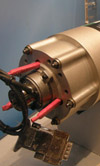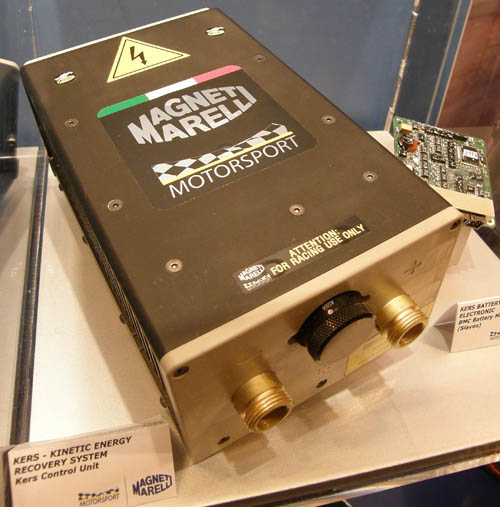Italian solution
 Despite the promise that kinetic energy recovery has offered in Formula One, even several races into the new season very few teams are choosing to race it. And, of those that are, the favoured solution seems to be based on a motor/generator for energy transfer and batteries as a storage medium. Both Ferrari and Renault have taken this route while McLaren, which is being tight lipped on the matter, certainly has such a system and may well be using it. In the battle to optimize all the variables, weight distribution seems to have been the main driver in this choice. The freedom to place the batteries low down and far forward is beneficial to car balance and this is where most of the ballast that the KERS system will be replacing normally sits.
Despite the promise that kinetic energy recovery has offered in Formula One, even several races into the new season very few teams are choosing to race it. And, of those that are, the favoured solution seems to be based on a motor/generator for energy transfer and batteries as a storage medium. Both Ferrari and Renault have taken this route while McLaren, which is being tight lipped on the matter, certainly has such a system and may well be using it. In the battle to optimize all the variables, weight distribution seems to have been the main driver in this choice. The freedom to place the batteries low down and far forward is beneficial to car balance and this is where most of the ballast that the KERS system will be replacing normally sits.
Magneti Marelli is Scuderia Ferrari’s technical partner for electronics and to get an insight into how such a system works we talked to the company’s motorsport director Roberto Dalla. As electronics is its business, it made sense for the company to investigate developing an electrical KERS solution for use in Formula One. But Dalla sees it as part of a bigger plan to develop a marketable KERS solution for road cars. He admits that Formula One is a long way removed from road cars but he says lessons learned in motorsport’s premier division would find their way into road car technology. Dalla also believes that, of all the solutions, an electrical system has the greatest potential for development.
Magneti Marelli has spent two years working on its system and is proud to be collaborating with a number of Formula One teams. From the start it was the intention to offer a turnkey solution that could be incorporated as a whole. But in time this strategy had to be revised. Because the battery is the biggest and heaviest part of the system, most teams have preferred to manage the development of that part of the system themselves. Consequently, Magneti Marelli has changed its approach to supplying discrete parts that customers can mix and match to suit their own solutions.
The Italian company’s hardware can work equally well with any form of electrical storage whether that be batteries, super-capacitors or an electrically driven flywheel. However, its favoured solution is Lithium Ion batteries. The other two major parts of the system are the motor/generator and the management electronics. The former is a synchronous AC motor/generator with permanent magnets yet this weighs only 4 kg and is about the size of a typical bottle of mineral water. A bigger challenge was the electronics. As Dallo points out, you are mixing high current, high voltage systems with microprocessors running on very low current and low voltages. Plus you are doing it in an environment with high electromagnetic interference and would be handing responsibility for installation to a third party who has many other considerations to accommodate.

Magneti Marelli’s solution was to tackle most of these challenges itself by incorporating everything into a single box. As Dalla points out, you can deliver a predefined solution and what works on the bench will work on the car. Also, shorter cable runs reduce weight and power loss as well as the risk of electromagnetic interference. The resulting unit is about the size of a shoebox but Dalla believes it offers the most efficient and reliable solution. The take up of the technology in Formula One may so far have been slow but Dalla insists that Magneti Marelli is able to supply a mature, reliable solution that can be adapted to any customer’s requirements. Understandably, he is tight lipped about who is using what Magneti Marelli parts in their Formula One cars but insists that the lessons being learned now will find their way into products marketed by the parent company for road cars.
Written by Charles Armstrong-Wilson.